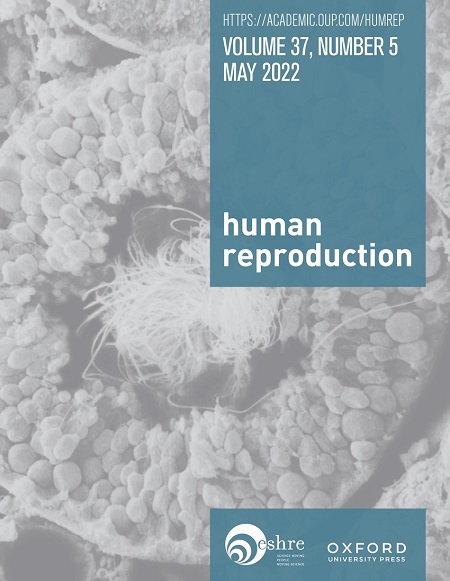The clinical impact of oligozoospermia in oocyte donation ICSI cycles using preimplantation genetic test for aneuploidy.
IF 6
1区 医学
Q1 OBSTETRICS & GYNECOLOGY
引用次数: 0
Abstract
STUDY QUESTION Do severely impaired sperm concentrations (oligozoospemia) in male factor infertility affect embryo aneuploidy rates and clinical results after IVF oocyte donation cycles? SUMMARY ANSWER Severe oligozoospermia (SO) in IVF cycles utilizing donor oocytes does not significantly affect embryo euploidy rates or IVF outcomes or cumulative live birth rates (CLBRs). WHAT IS KNOWN ALREADY SO has previously been linked to elevated rates of chromosomal abnormalities in spermatozoa and altered rates of embryo development with poorer reproductive outcomes. Nonetheless, the precise impacts of severe male factor infertility on embryonic aneuploidy rates and the success of IVF, in the context of controlled female ages in oocyte donation cycles with preimplantation genetic testing for aneuploidy (PGT-A), are still not fully understood. STUDY DESIGN, SIZE, DURATION This retrospective observational cohort study involved 690 IVF oocyte donation cycles undergoing PGT-A from multiple clinics across Europe between January 2017 and December 2023. The study population was divided into three groups based on sperm concentration: SO (<5 million sperm/ml), moderate oligozoospermia (MO, 5-16 million sperm/ml), and a normozoospermia control group (≥16 million sperm/ml) for outcome analysis. PARTICIPANTS/MATERIALS, SETTING, METHODS The IVF outcomes and variables for couples undergoing oocyte donor cycles were investigated. ICSI was performed in all cycles using fresh sperm samples that were assessed for standard semen parameters with fresh or frozen donated oocytes. All of the resulting embryos were biopsied at the blastocyst stage for PGT-A, and all transfers were of single embryos performed in subsequent cycles after vitrification and warming. Statistical analysis was performed using multivariate regression models to identify correlations between rates of oligozoospermia and clinical, embryological and genetic outcomes. MAIN RESULTS AND THE ROLE OF CHANCE The study included 690 couples, in the SO (N = 202), MO (N = 102), and the control normozoospermia (N = 386) groups. The SO group had significantly lower sperm motility (P < 0.0001) and significantly reduced fertilization rates compared to the MO and control groups (P < 0.01). However, no statistical difference was observed for the blastocyst formation rate (per fertilized oocyte). Mostly due to the reduced fertilization rates, the number of euploid blastocysts obtained was significantly lower in the SO group (P = 0.007), however, this did not affect the pregnancy, biochemical or clinical miscarriage (P = 0.37, P = 0.22, and P = 0.86), or CLBRs (P = 0.26) after single blastocyst transfers. The multivariate analysis showed no effect of SO or MO on aneuploidy, miscarriage, or live birth rates. Interestingly, the PGT laboratory strategy (<0.001) was associated with the rate of euploid blastocysts but had no significant effect on pregnancy outcomes. LIMITATIONS, REASONS FOR CAUTION This is a retrospective observational study focusing on outcomes associated with reduced sperm concentration. Other elements of severe male factor infertility may have different associations with outcomes. Also, potential confounding factors including male lifestyle factors that can influence sperm quality were not considered. WIDER IMPLICATIONS OF THE FINDINGS In this oocyte donation setting, we demonstrated that SO is unlikely to significantly affect IVF outcomes following blastocyst development, which contradicts previous findings in less controlled settings. This suggests that male factor infertility in the setting of oocyte donation is not an indication per se to perform PGT-A. These results provide reassurance for couples when undergoing treatment with oocyte donation that any related male factor infertility will not significantly impact treatment outcomes. Further research should use similar controlled oocyte donation settings to investigate other severely impaired sperm parameters to better understand associations with paternal embryonic aneuploidy and IVF outcomes, guiding a more informed path for male factor infertility treatment. STUDY FUNDING/COMPETING INTEREST(S) No external funding was used and the authors have no conflicting interests. TRIAL REGISTRATION NUMBER N/A.使用非整倍体植入前遗传学检测卵母细胞捐赠ICSI周期中少精症的临床影响。
研究问题:男性因素不育患者的精子浓度严重受损(少精子症)是否会影响体外受精卵母细胞捐赠周期后的胚胎非整倍体率和临床结果?在使用供体卵母细胞的体外受精周期中,严重少精症(SO)不会显著影响胚胎整倍体率、体外受精结果或累积活产率(clbr)。已知情况:先前已发现与精子染色体异常率升高和胚胎发育率改变以及较差的生殖结果有关。尽管如此,在卵母细胞捐赠周期中控制女性年龄并进行着床前非整倍体基因检测(PGT-A)的背景下,严重男性因素不育对胚胎非整倍体率和体外受精成功率的确切影响仍未完全了解。研究设计、规模、持续时间这项回顾性观察队列研究涉及2017年1月至2023年12月期间来自欧洲多家诊所接受PGT-A的690个IVF卵母细胞捐赠周期。研究人群根据精子浓度分为三组:SO(< 500万精子/ml),中度少精症(MO, 5- 1600万精子/ml)和正常精子症对照组(≥1600万精子/ml)进行结局分析。研究对象/材料、环境、方法对接受卵母细胞供体周期的夫妇进行体外受精(IVF)结果和变量的调查。在所有周期中使用新鲜精子样本进行ICSI,用新鲜或冷冻捐赠的卵母细胞评估标准精液参数。所有得到的胚胎在囊胚期进行活组织检查以检测PGT-A,所有移植的胚胎都是在玻璃化和加热后的后续周期中进行的单个胚胎。使用多元回归模型进行统计分析,以确定少精症发生率与临床、胚胎学和遗传结果之间的相关性。本研究共纳入690对夫妇,分别为无精子症组(N = 202)、无精子症组(N = 102)和正常精子症对照组(N = 386)。与MO组和对照组相比,SO组精子活力显著降低(P < 0.0001),受精率显著降低(P < 0.01)。然而,在囊胚形成率(每受精卵)方面没有观察到统计学差异。SO组获得的整倍体囊胚数量明显减少(P = 0.007),主要原因是受精率降低,但这并不影响单囊胚移植后的妊娠、生化或临床流产(P = 0.37、P = 0.22和P = 0.86)或CLBRs (P = 0.26)。多变量分析显示,SO或MO对非整倍体、流产或活产率没有影响。有趣的是,PGT实验室策略(<0.001)与整倍体囊胚率相关,但对妊娠结局没有显著影响。这是一项回顾性观察性研究,关注与精子浓度降低相关的结果。严重男性因素不育的其他因素可能与结果有不同的关联。此外,包括男性生活方式因素在内的潜在混杂因素也没有考虑到,这些因素可能会影响精子质量。在这种卵母细胞捐赠环境中,我们证明了SO不太可能显著影响囊胚发育后的IVF结果,这与之前在较少控制环境中的发现相矛盾。这表明,在捐赠卵母细胞的情况下,男性因素不育本身并不是进行PGT-A的指征。这些结果为接受卵母细胞捐赠治疗的夫妇提供了保证,任何相关的男性因素都不会显著影响治疗结果。进一步的研究应该使用类似的受控卵母细胞捐赠设置来调查其他严重受损的精子参数,以更好地了解与父亲胚胎非整倍体和体外受精结果的关系,为男性因素不育的治疗提供更明智的途径。研究经费/利益冲突(S)没有使用外部资金,作者没有利益冲突。试验注册号/ a。
本文章由计算机程序翻译,如有差异,请以英文原文为准。
求助全文
约1分钟内获得全文
求助全文
来源期刊

Human reproduction
医学-妇产科学
CiteScore
10.90
自引率
6.60%
发文量
1369
审稿时长
1 months
期刊介绍:
Human Reproduction features full-length, peer-reviewed papers reporting original research, concise clinical case reports, as well as opinions and debates on topical issues.
Papers published cover the clinical science and medical aspects of reproductive physiology, pathology and endocrinology; including andrology, gonad function, gametogenesis, fertilization, embryo development, implantation, early pregnancy, genetics, genetic diagnosis, oncology, infectious disease, surgery, contraception, infertility treatment, psychology, ethics and social issues.
 求助内容:
求助内容: 应助结果提醒方式:
应助结果提醒方式:


